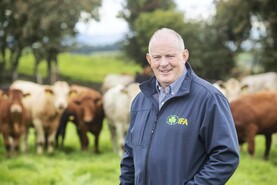In this week's edition, we carry an interview with Minister for Environment Eamon Ryan. His vision for the future of beef farming in Ireland, one where animals meander over wetlands during the dry summer months, is in stark contrast to the roadmap Teagasc presented to farmers this week.
The minister also appears confident that there is a consumer base willing to pay a premium for the beef from these animals “grazing peaty soils in a sustainable away”.
Does this view align with that of Bord Bia? What market research has been done to support his theory?
Also, if this is the policy direction from Government, where was the economic modelling and production blueprints for these types of beef systems at Teagasc’s open day?
On methane, Minister Ryan either does not appear to be aware of or is unwilling to accept/acknowledge the scientific consensus showing that expressing agriculture’s contribution to global warming using carbon dioxide equivalents (CO2-e) is flawed – identified by the Intergovernmental Panel on Climate Change to overstate the impact of constant methane emissions on global surface temperature by a factor of three to four.
While the minister’s comments – that farmers shouldn’t be the fall guys if climate targets are missed – is welcome, the sincerity is undermined by his instance that every sector must “go to the max” when it comes to targets.
For agriculture, the max is 30% and the consequences – as shown in the Irish Farmers Joural-commissioned KPMG report – are an 18-22% reduction in cattle numbers, 56,400 job losses and an annual hit to economic output of €3.8bn.
Unfortunately going to the max will, for many farmers, mean going to the wall.
This week's cartoon

\ Jim Cogan
Grain back but could rise again
Grain and other feed ingredient prices have seen huge volatility since the Russian invasion of Ukraine on 24 February. That volatility continues but prices have dropped in recent weeks as harvesting progresses across much of the northern hemisphere.
In the weeks following the invasion, markets moved to secure access to product. In recent weeks, markets are more concerned about anticipated demand and buyers are nervous about buying product in advance of need.
Feed mills have taken a level of forward cover at higher price levels to secure basic supply amounts but this is generally only a small proportion of total needs. This policy seems to have served them well, given the current direction of prices, but there could be another spike in the market if weather-related problems are encountered in north or south America. As of now, the potential for very big harvests in both continents is high but weather could reduce or enhance these expectations.
The feed market here does not show specific loyalty to native grains but neither does the food supply chain acknowledge or reward full native provenance. While this is the case, native grains must be able to compete with imports on price and value and the market has been attempting to do that over the past month or more. Forward sales and hedges will be honoured but there was very little uptake on these by sellers when price levels were much higher.
Grass growth: is reduced nitrogen starting to bite?
So far, most farmers are reporting good grass growth rates and in general silage crops have yielded well – even where nitrogen rates were slightly reduced. But as the season progresses, are we starting to see reduced N application on grazing ground affect sward quality? It is important that growth rates are monitored carefully in the weeks ahead and that corrective action is taken to improve swards where quality has declined.
In some instances, this may require topping along with an application of N. Failing to correct any issues now could lead to grass deficits in early autumn. Read more in this week’s management notes.
In this week's edition, we carry an interview with Minister for Environment Eamon Ryan. His vision for the future of beef farming in Ireland, one where animals meander over wetlands during the dry summer months, is in stark contrast to the roadmap Teagasc presented to farmers this week.
The minister also appears confident that there is a consumer base willing to pay a premium for the beef from these animals “grazing peaty soils in a sustainable away”.
Does this view align with that of Bord Bia? What market research has been done to support his theory?
Also, if this is the policy direction from Government, where was the economic modelling and production blueprints for these types of beef systems at Teagasc’s open day?
On methane, Minister Ryan either does not appear to be aware of or is unwilling to accept/acknowledge the scientific consensus showing that expressing agriculture’s contribution to global warming using carbon dioxide equivalents (CO2-e) is flawed – identified by the Intergovernmental Panel on Climate Change to overstate the impact of constant methane emissions on global surface temperature by a factor of three to four.
While the minister’s comments – that farmers shouldn’t be the fall guys if climate targets are missed – is welcome, the sincerity is undermined by his instance that every sector must “go to the max” when it comes to targets.
For agriculture, the max is 30% and the consequences – as shown in the Irish Farmers Joural-commissioned KPMG report – are an 18-22% reduction in cattle numbers, 56,400 job losses and an annual hit to economic output of €3.8bn.
Unfortunately going to the max will, for many farmers, mean going to the wall.
This week's cartoon

\ Jim Cogan
Grain back but could rise again
Grain and other feed ingredient prices have seen huge volatility since the Russian invasion of Ukraine on 24 February. That volatility continues but prices have dropped in recent weeks as harvesting progresses across much of the northern hemisphere.
In the weeks following the invasion, markets moved to secure access to product. In recent weeks, markets are more concerned about anticipated demand and buyers are nervous about buying product in advance of need.
Feed mills have taken a level of forward cover at higher price levels to secure basic supply amounts but this is generally only a small proportion of total needs. This policy seems to have served them well, given the current direction of prices, but there could be another spike in the market if weather-related problems are encountered in north or south America. As of now, the potential for very big harvests in both continents is high but weather could reduce or enhance these expectations.
The feed market here does not show specific loyalty to native grains but neither does the food supply chain acknowledge or reward full native provenance. While this is the case, native grains must be able to compete with imports on price and value and the market has been attempting to do that over the past month or more. Forward sales and hedges will be honoured but there was very little uptake on these by sellers when price levels were much higher.
Grass growth: is reduced nitrogen starting to bite?
So far, most farmers are reporting good grass growth rates and in general silage crops have yielded well – even where nitrogen rates were slightly reduced. But as the season progresses, are we starting to see reduced N application on grazing ground affect sward quality? It is important that growth rates are monitored carefully in the weeks ahead and that corrective action is taken to improve swards where quality has declined.
In some instances, this may require topping along with an application of N. Failing to correct any issues now could lead to grass deficits in early autumn. Read more in this week’s management notes.







 This is a subscriber-only article
This is a subscriber-only article











SHARING OPTIONS: